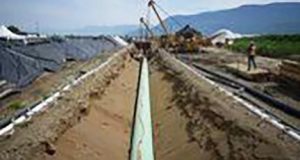By Abby Francis
Local Journalism Initiative Reporter
Tla’amin Nation has owned tenures in the Okeover and Theodosia areas for over 45 years and the business arm, Tla’amin Management Services LP, re-entered the aquaculture business in 2018. Its main operations, under Pa’aje Shellfish LP, are in the tox?na? (Okeover) area which contains an astonishing 12 acres, one of the biggest in the area.
Within this area, Pa’aje operate on three different beaches: two-acre West beach, three-acre East beach, and seven acres on the Okeover Head beach.
Most of the operation right now is using the West beach, which was a good move, because it is Northeast facing, this beach gets mostly afternoon shade at the hottest times of the day.
This beach is also almost all sand, meaning the ground is more porous, allowing good air circulation, which protects the oysters from fluctuating heat temperatures. This location came in handy earlier this summer when the heat dome occurred on the West Coast.
Many oyster farmers suffered hundreds of thousands of losses in product and in money. The Tla’amin Oyster farm lost a minimal amount of product compared to others. Some oysters located on the pebbly part of the beach died. In the heat, the oysters that inhabit on top of the rocks, further up the beach get overheated, whereas the oysters that are mid-way through the beach are more protected and survive.
Oysters are collected in a three-month rotation, giving smaller oysters time to grow larger into a marketable product. The oysters are collected in bags and are filled with approximately 120 oysters ranging in sizes that are sold to a variety of buyers. Weekly sales on average are 300-400 bags. However, their schedule is based on the tides, meaning summers are long hours during the day, and during the winter, there are long cold nights.
The oyster growth process is a bit long, but very rewarding. The oyster seeds are bought from a company called Nova Harvest in Bamfield. The seeds are a similar size to a grain of rice when they are received. The seeds are taken and put into a machine called a flupsy. A flupsy is a `Floating Upweller System,’ which is used to grow shellfish in the open water while protecting them from predators until they are large enough to survive. The flupsy keeps the oysters in the seawater protected and allows for 24-hour feed rotation. The workers spend each day working with the machine and cleaning the tanks the oysters are held in. They also take out the tanks to separate the smaller oysters from the larger oysters.
After being in the flupsy for six to eight months, when they’re about the size of a toonie, the oysters are large enough to move to pouches that float along the ocean surface until mid-October, when it is cool enough for the oysters to be laid on the beach. After being placed on the beach, the growth process is a bit slower as the oysters acquire nutrition that comes in and out with the tides; this is the natural process. The oysters continue to grow for about a year, then they will start being collected for market sales.
Summer months for oyster harvest are much slower, because after mid-June, vibrio, like salmonella in poultry, is a worry for shellfish consumption. To make up for this lower sales period, the workers take up clam digging on the beach as added business income.
A huge farm like this must have lots of workers, right? Well, while they are looking for employees, currently, this operation is run by a mere three people: manager Claude Patenaude, his son Russell Patenaude, and Dean Louie from the Tla’amin Nation.
“We compete with each other every day, seeing how many bags of clams and oysters we can fill up, right now we are doing about 40-42 bags a day. In the end, we all get along and have a good time, but it’s a great way to make the most before the tide kicks us off the beach,” says Claude.
The farm sees a lot of wildlife. “Because there aren’t really people out here, we see wildlife pretty much every day,” Claude says. Bears, raccoons, birds, waterfowl, deer, and mink all are commonly seen. “Land mammals are not really a problem for the shellfish, however, sea creatures, on the other hand, are,” says Claude.
Crabs are the biggest problem for the farm. They posed such a big threat that the farm invested in a predator net to help keep crabs out. While there are some smarter ones who make it over, they become trapped on the other side as the tide goes out. Claude explained that the crabs will pinch at the lips of the oyster, breaking the shell, leaving the inside defenseless, as the crabs devour the oysters.
With many business years to come, the Pa’aje Oyster Farm has a bright future ahead of it, with a dedicated staff, and operation.
Tla’amin soon will have not only a productive oyster farm, but also a geoduck operation, as they are currently working on a geoduck tenure located near ?agayqs?n (Ahgykson or Harwood Island.) The geoduck process is much longer than the oysters, taking seven years to grow the large clam-like molluscs into a sellable market size versus the two years oysters take to grow. Despite this, the market prices for geoducks are much higher than oysters, which will help create sustainable income for the Tla’amin Nation in future years.
Abby Francis is a Local Journalism Initiative reporter who works out of QATHET LIVING . The Local Journalism Initiative is funded by the Government of Canada.
 Aboriginal Business Magazine Your source for Aboriginal Business News
Aboriginal Business Magazine Your source for Aboriginal Business News


